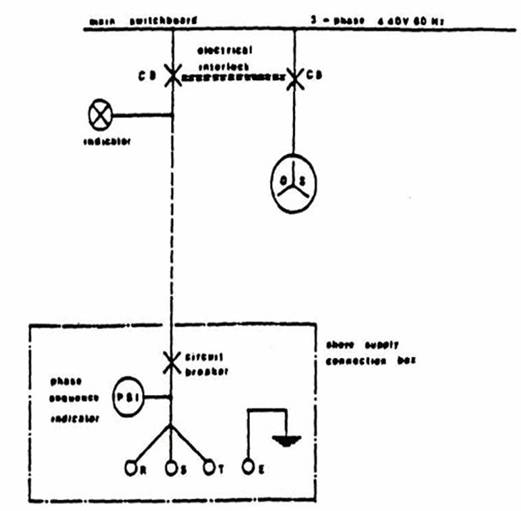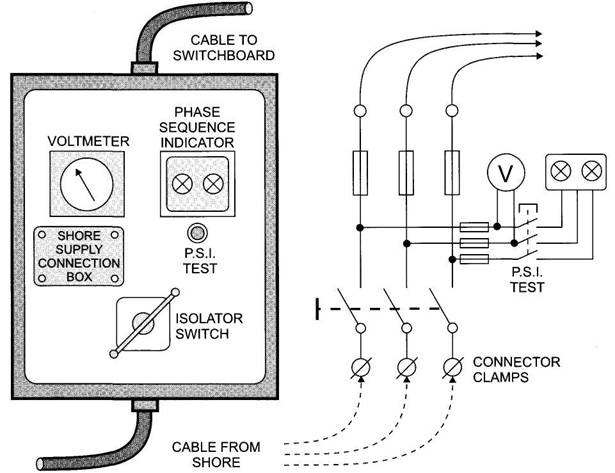Question
Describe the requirement of each of
the following electrical equipment.
A shore to
ship supply of alternating current.
Portable lighting
for inspection of duct keel space.
.



A shore-supply is required so that
the ship's generators and their prime-movers can be shut down for major
overhaul during a dry-docking period.
For an ac shore supply a phase
sequence indicator is fitted to indicate correct supply phase sequence. At the
main switchboard an indicator is provided, usually a lamp, to indicate that the
shore supply is available for connection to the bus bars via a connecting
switch or circuit-breaker. It is not normally possible to parallel the shore
supply with the ship’s generators. The ship’s generators must, therefore, be
disconnected before the shore supply can be conne3cted to the main switchboard
is interlocked with the generator circuit-breakers so that it cannot be closed
if the generators are still connected.
b) Faulty hand-held tools powered
by a.c. and having metal casings could impart a
lethal shock to the operator where the fault causes the casing to be live. The
hand(s) gripping the tool provide a large contact area (possibly damp with
perspiration) so that sufficient alternating current might flow to prevent
relaxation of the hold, and such a current could result in fatality. The risk
of shock is increased if the operator is working in damp conditions and
standing on metal plates or touching metal structure. There are similar risks
with various types of portable or semi-portable appliances - particularly lead
lamps.
The metal casings of portable
appliances are connected to earth through the earth wire in the three-core
cable and the earth pin in the plug, to give protection against a fault which could
make the casing live. Frequently, rough handling of portable equipment not only
causes the fault which makes the casing live, but also causes the earth wire to
be broken. Thus, when electrical connections and insulation are checked in the
course of regular inspection and cleaning, the earth core of the electric cable
should also be tested for continuity (i.e. with one terminal of the tester on
the metal casing of the appliance and the other on the earth pin of the plug).
Shock risk from portable tools is
greatly reduced if the power supply is taken from the secondary winding of a
transformer used to step down the mains supply to a suitable lower voltage,
with the mid-point of the secondary winding earthed.
If the secondary voltage is limited
to 110 V for operation of the single-phase appliance, then the potential shock voltage
between the casing and earth is limited to 55 V. (Secondary voltage can be made
lower if required.)
Double-pole switches are fitted to
control single-phase appliances fed in this way.
Flexible cable for portable tools
and equipment is reinforced and given extra protection by a rubber tube where
it enters the appliance.
Here and at the plug end the cable
is subject to bending and pulling: it can also be damaged along its length by
being pinched or cut by sharp edges and by touching a hot surface or lying in
oil, chemical or water. Sometimes the cable is cut by the tool being used.
Damage to the cable can cause shock
in a number of ways, or an earth or a short-circuit.